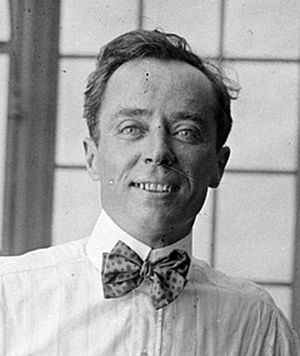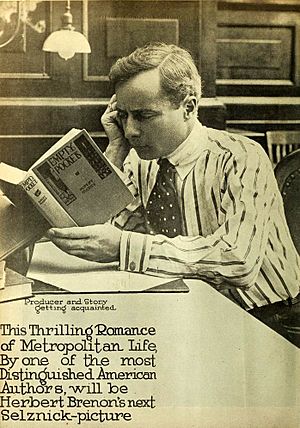Herbert Brenon facts for kids
Quick facts for kids
Herbert Brenon
|
|
|---|---|

Herbert Brenon, 1916
|
|
| Born |
Alexander Herbert Reginald St. John Brenon
13 January 1880 Kingstown, Ireland
|
| Died | 21 June 1958 (aged 78) Los Angeles, California, U.S.
|
| Alma mater | King's College London |
| Occupation | Film director |
| Years active | 1911–1940 |
| Spouse(s) | Helen Oberg (m. 1904-1955; her death) |
| Children | 1 |

Herbert Brenon was a famous film director, actor, and writer from Ireland. He was born on January 13, 1880, and passed away on June 21, 1958. He made many movies during the silent film era, which was a time before movies had sound. His career lasted until 1940.
Brenon was one of the first filmmakers who had a lot of control over his movies. He was like an "auteur", meaning he guided almost every part of making his films. Many people thought his movies were as good as those made by other film pioneers like D. W. Griffith.
He was also one of the first directors to become a celebrity. People knew his name because his movies often had amazing special effects and grand scenes. Some of his most well-known films include Neptune's Daughter (1914), Peter Pan (1925), A Kiss for Cinderella (1925), and the first film version of Beau Geste (1926).
Contents
Early Life and Education
Herbert Brenon was born in Kingstown, Ireland, which is now called Dún Laoghaire. His father, Edward St. John Brenon, was a journalist, poet, and politician. His mother was Frances Harris.
In 1882, when Herbert was two years old, his family moved to London, England. He went to St Paul's School and later to King's College London. When he was 16, in 1896, Brenon moved to the United States. He became a U.S. citizen in 1918.
Starting a Film Career
When he was a teenager, Brenon worked odd jobs in the theater world. He was an office boy for a theater agent and a call boy at Daly's Theatre in New York City. Before he became a director, he also performed in vaudeville shows. Vaudeville was a popular type of entertainment with many different acts. He even ran a small movie theater called a nickelodeon.
Brenon married Helen Violette Oberg in 1904. They met while working in vaudeville. Their son, Herbert Cyril Brenon, was born in 1906.
Early Directing Days: IMP Studios
At 29, Brenon started writing and editing films for the Independent Moving Pictures Company (IMP). This company later became Universal Studios. In 1911, he directed his first movie, a short film called All For Her. He also acted in many of the films he directed for IMP.
In 1913, Brenon took his film crew to Europe. He made several movies in England, France, and Germany. One of his most exciting films from this time was Ivanhoe. This movie was based on a famous novel by Sir Walter Scott. It was filmed at Chepstow Castle in England. People loved it, saying it would be a very important film in movie history.
Brenon's last big film for IMP was Neptune’s Daughter in 1914. This movie starred Annette Kellerman, a famous swimmer and actress. It was filmed in Bermuda and was quite long for its time. This film helped make both Brenon and Kellerman early movie stars. After this, Brenon left IMP to start his own film company, but it didn't last long.
Working with Fox Film Corporation
In 1915, Brenon and Annette Kellerman began working with William Fox’s film company. Brenon directed actress Theda Bara in films like The Two Orphans (1915). Both Brenon and Bara helped make the Fox Company much more important in the film world.
A Daughter of the Gods (1915)
In 1915, Brenon and Kellerman went to Jamaica to make a very grand film called A Daughter of the Gods. Brenon spent a lot of money making this movie. He even built a whole city set for it! This caused problems with producer William Fox, who was upset about the high costs. Fox took over the film and edited it himself, even removing Brenon's name from the credits. Brenon tried to sue Fox, but he lost. After this, he left Fox and directed films for other studios.
Success at Paramount Pictures
From 1923 to 1926, Brenon worked at Paramount. This was a very successful time for him. He became known as a highly skilled filmmaker with a special movie style.
Two films that show off "the Brenon style" were his adaptations of J. M. Barrie's fantasy stories: Peter Pan (1924) and A Kiss for Cinderella (1925). For these movies, Brenon worked with talented cinematographers like James Wong Howe to create amazing lighting and camera effects.
One of Brenon's most popular movies at Paramount was Beau Geste (1926), starring Ronald Colman. This film was praised for its smart storytelling and strong acting.
Directing Style and Personality
Herbert Brenon was known for getting great performances from actors, even those who were sometimes difficult to work with. He believed that actors needed "temperament" to truly bring their characters to life. He said that the more emotional an actor was, the easier it was for them to understand a role and make it real.
Many famous actors, like Pola Negri and Lon Chaney, gave some of their best performances in Brenon's films. He was very good at working with a wide range of silent film stars.
Brenon was sometimes described as a bit grumpy on set. He was one of the "old-school" directors who liked to be in charge of everything. However, as big movie studios grew more powerful in the 1920s, this style became less common.
Actress Louise Brooks remembered Brenon's good directing when she made her first film, The Street of Forgotten Men (1925). But she also recalled a time when a sandbag almost hit Brenon, suggesting some people on set might not have liked his demanding style. Another director, Edward Bernds, said Brenon was very bossy. He remembered Brenon demanding real money be used and torn up for a scene, which caused problems for the prop crew.
Later Years and Legacy
When movies started to have sound, Brenon's career in the United States slowed down. Many directors from the silent film era found it hard to adapt to the new "talkie" films.
However, Brenon's career got a boost when he moved to England in the mid-1930s. He made several more movies there. His last film, The Flying Squad, was completed in 1940.
Before he passed away, Brenon was writing his autobiography. He even asked Mary Brian, who played Wendy in his Peter Pan movie, to paint her idea of Never-Neverland for the book. Sadly, he died before he could finish it.
Herbert Brenon died in Los Angeles on June 21, 1958, at the age of 78. He was buried in a private mausoleum at Woodlawn Cemetery in New York.
Partial Filmography
- All of Her (1912)
- Dr. Jekyll and Mr. Hyde (1913)
- Ivanhoe (1913)
- Kathleen Mavourneen (1913)
- Absinthe (1914)
- Neptune's Daughter (1914)
- The Kreutzer Sonata (1915)
- The Heart of Maryland (1915)
- The Clemenceau Case (1915)
- The Two Orphans (1915)
- Sin (1915)
- The Soul of Broadway (1915)
- A Daughter of the Gods (1916)
- The Ruling Passion (1916)
- War Brides (1916)
- Whom the Gods Destroy (1916)
- The Fall of the Romanoffs (1917)
- The Lone Wolf (1917)
- Empty Pockets (1918)
- Victory and Peace (1918)
- The Passing of the Third Floor Back (1918)
- 12.10 (1919)
- Beatrice (1919)
- The Mysterious Princess (1920)
- The Passion Flower (1921)
- The Stronger Passion (1921)
- Little Sister (1921)
- The Wonderful Thing (1921)
- Moonshine Valley (1922)
- Shackles of Gold (1922)
- A Stage Romance (1922)
- The Custard Cup (1923)
- The Spanish Dancer (1923)
- The Breaking Point (1924)
- Shadows of Paris (1924)
- The Alaskan (1924)
- Peter Pan (1924)
- The Side Show of Life (1924)
- The Street of Forgotten Men (1925)
- The Little French Girl (1925)
- A Kiss for Cinderella (1925)
- The Song and Dance Man (1926)
- God Gave Me Twenty Cents (1926)
- Dancing Mothers (1926)
- The Great Gatsby (1926)
- Beau Geste (1926)
- The Telephone Girl (1927)
- Sorrell and Son (1927)
- Laugh, Clown, Laugh (1928)
- The Rescue (1929)
- The Case of Sergeant Grischa (1930)
- Lummox (1930)
- Transgression (1931)
- Girl of the Rio (1932)
- Wine, Women and Song (1933)
- Honours Easy (1935)
- Royal Cavalcade (1935)
- Someone at the Door (1936)
- Living Dangerously (1936)
- The Live Wire (1937)
- Spring Handicap (1937)
- Housemaster (1938)
- Yellow Sands (1938)
- Black Eyes (1939)
- The Flying Squad (1940)
Images for kids
-
Brenon's mausoleum in Woodlawn Cemetery in New York



